|
THE COMPLETE

Indie Zone started
life as a very small column called Free Play in the news section of
PC Zone, covering freeware releases. After just two issues, it was
incorporated into a proper regular section featuring commercial
independent games as well as freeware, and ran for just under a
year, until the magazine was bought by Future Publishing and your
correspondent was summarily fired. Since it's basically just a bunch
of small game reviews, the whole thing has been collected here onto a
single page, with obsolete original links updated to the best
available live ones at the time of writing.
FREE PLAY - ISSUE 138 (Feb 2004)
Achtung viewers! Welcome to Free Play,
an excellent new regular section of PC Zone in which we bring you
the very best in free PC gaming. It’s probably worth taking a minute
to define our terms – for the purposes of this column, “free” is
defined as a game you can obtain in its entirety without paying for
in advance. Therefore, shareware games which come as a few levels,
with the whole game available only when you pay for it, are NOT
eligible for inclusion here. On the other hand, games which you can
download/play in their entirety, but are invited to subsequently pay
for if you enjoyed them, ARE allowed - naturally, we strongly
encourage you to play fair with such games and make the requested
donation if you feel the game is worth it. But what we’re mostly
going to be focussing on here are games which are completely and
permanently free, which some enormously generous soul has created
and distributed for nothing other than the sheer philanthropic joy
of sharing them with fellow gamers, and which fill Free Play’s heart
with a warm and glowing love for humanity.
Such a game is our first offering, the
glorious Warning Forever. An all-boss freeware shoot-‘em-up from
Japan, Warning Forever does something that’s been sadly missing from
shooting games ever since R-Type – giant enemy ships you can blow up
piece by piece, rather than just having to pour fire into one weak
spot for hours until the whole thing illogically explodes. There’s
far more gameplay cleverness to discover in Warning Forever than we
have space to tell you about here, so just dive right in, admire the
aesthetic and design elegance, and then destroy it. With bullets.
http://www18.big.or.jp/~hikoza/Prod/

|
FREE PLAY - ISSUE 139 (Mar 2004)
Atari’s classic Super Sprint belongs
to a special category of games – the victims of technology. Like 2D
platformers and football games you don’t need a degree in rocket
science to play, racing games viewed from overhead where you can see
the entire track all the time simply don’t get made in the 3D era.
It’s a bit weird, because there’s no logical reason that people
would suddenly stop enjoying that style of gameplay just because
some completely different kind of racing games also became available
– if a new limited-edition Mars bar comes out, you don’t stop liking
roast beef, do you?
Anyway, where the games industry fails
us, you can be sure that heroic bedroom coders will step into the
breach, and so it is with Super Sprint games. GeneRally (Free Play
is unable to ascertain if you’re supposed to pronounce it as
“generally” or “Jean Rally”) is a simple and
ultra-customisable engine for the creation of Super Sprint-type
racing larks, and has spawned a huge mod community creating
countless original and inventive race tracks, but also – and as far
as Free Play is aware, this is a first for the genre – accurate
mappings of real-life race tracks.
When you come to think about it, it’s
kinda odd that nobody ever released a commercial Super Sprint-style
game featuring real racetracks, but it doesn’t matter now, because
dedicated GeneRally fans have mapped and translated Monaco, Spa
Francorchamps, the Hungaroring and all your other favourites, all in
a variety of styles (some, for example, just recreate the track’s
basic shape to whizz round in a few seconds, while others use the
game’s alterable scale function to implement realistic length, so
that a lap takes a couple of minutes in real time). You can race in
all manner of different vehicles, on street or rally tracks, against
humans or computer opponents with individually-selectable skill
ratings, and just generally tweak and tune everything until you’ve
created the Super Sprint game of your dreams. Sweet.
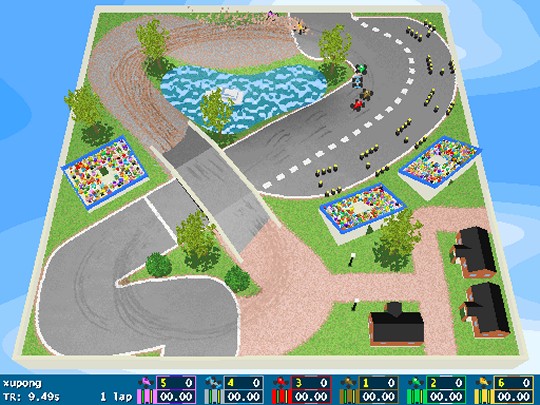
http://generally.rscsites.org/ - central hub for new versions
and extra tracks
|
INDIE ZONE - ISSUE 140 (Apr 2004)
As alert readers will have noticed,
here at PC Zone we’ve been devoting quite a bit of attention
recently to independent developers, that endangered species
representing the last link to the legendary days of the “bedroom
coder”. But after the big feature in PCZ137, we got to thinking
“But what’s the use of us bigging-up indies if we never look at
the scene the other 12 months of the year?” (Because as you’ll
know as an alert reader, for magazine writers there are 13 months in
a year.) And therefore – welcome to Indie Zone.
Here every month we’ll be reviewing
games from indie developers/publishers which, in most cases, you
won’t be able to buy in shops, only direct from the authors. They’ll
be judged by the same standards as any other game – no “special
treatment” for being independent – and hopefully we’ll find you a
few gems hidden away down a different road from the somewhat generic
“FPS, RTS, RPG, football” release schedules of the majors. If you’ve
got any comments on Indie Zone (such as, purely for example,
“Make Indie Zone bigger!”), feel free to forward them to the
editor. So on with the show.
KAYAK EXTREME
Small Rockets $14.99 (about £8.50 at time of writing)
In several ways, Kayak Extreme
typifies what independent development is all about. A fairly sedate
and technical game about downhill canoeing, it’s hard to imagine any
major publisher ever greenlighting it. But that doesn’t mean it’s
been produced to lesser standards than the average High Street PC
game – the graphics, as you can see, are beautiful, and the
turbulent streams you paddle down highly convincing. Where the game
does let itself down, though, is in a needlessly complex control
system, with a messy, unintuitive and non-reconfigurable keyset, and
a pace that may be realistic, but seems a little ponderous when you
don’t have the excitement of real showers of icy spray crashing into
your face and the constant threat of drowning after having your head
caved in by rocks. Still, the PC gaming market is one where people
tend to lap up relatively dull and “accurate” simulations in
preference to exaggerated arcade thrills, so if the idea of Kayak
Extreme appeals to you the execution may well also. To Indie Zone,
however, it seems like something of a missed opportunity.
PC
ZONE VERDICT: Not nearly “Extreme” enough. 55%
http://www.smallrockets.com/pc/kayak/

You’ll come to loathe red “reverse” gates.
FREE PLAY - Super
Mario Pac (Hermit Games)
WARNING: The
following paragraph contains the phrase “self-referential
cross-pollination”. Please note – this is not dirty. Don’t write us
angry letters about it. Thank you. You may now return to your
column. (Fnar!)
One of the reasons videogaming culture
gets so little respect in the real world is that it has so few
examples of self-referential cross-pollination like this. Super
Mario Pac spans three entire generations of gaming – it takes the
basic game design of classic Spectrum title Jet-Pac, the setting and
aesthetics of seminal SNES platformer Super Mario World (by
Nintendo, who would later go on to buy part of Rare, the company who
made Jet-Pac), and the core gameplay mechanic of the Gamecube’s
Mario Sunshine, and melds them together into a slick and
professional piece of PC freeware. It’s practically a historical
document. It’s also, however and more importantly, a fab little
game. Adding a few simple tweaks to the Jet-Pac gameplay brings
Super Mario Pac right into the world of the Mushroom Kingdom, to the
extent that you could easily picture this game being given away with
future Mario titles on the Game Boy Advance, like the original Mario
Bros is nowadays. There’s no room to tell you more, so fire up your
coverdisc and see for yourself.
http://www.hermitgames.com/mariopac.html
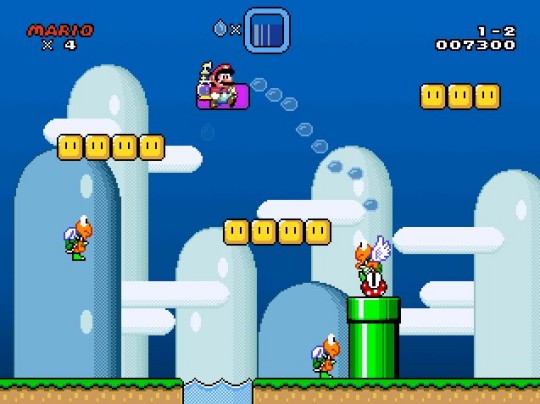
A world where water kills turtles.
|
INDIE ZONE - ISSUE 141 (May 2004)
As Sega have recently shown by
launching a lawsuit at Acclaim over the uncanny resemblance between
Simpsons Hit And Run and Crazy Taxi, the issue of plagiarism isn’t
dead in the world of videogaming, and nowhere is it more acutely
felt than on the independent scene. A huge number of indie titles
are still barely-concealed unlicenced clones of other people’s
games, yet rather than condemn this intellectual piracy, the indie
community often reacts with vitriolic defensiveness at anyone who
raises the subject. Keep your eyes peeled for a full-blown Indie
Zone investigation, but in the meantime, don’t expect to see any
blatant ripoffs covered here.
AIRSTRIKE 3D
Divo Games £11.06 (£16.58 with CD)
Min spec: PII-333, 64MB RAM, 3D card
The on-rails scrolling shoot-‘em-up is
one of the genres that’s tragically fallen by the wayside in the
modern era of PC gaming. While pyrotechnic 2D blasters like
Shikigami No Shiro and Ikaruga still command niche appeal on
consoles, and semi-3D titles like Zero Gunner fashion the same
gameplay into showcases for modern graphics, the PC’s been largely
bypassed in the new age of shmups. Thank Jeebus, then, for the likes
of Airstrike 3D. Visually reminiscent of EA’s “Strike” series of
games, this is a no-nonsense helicopter shooter set across 20 levels
of implausibly-heavily-defended river valleys. (It’s weird when
games like this put you in a helicopter, because the primary
characteristic of a chopper is being able to hover in one place,
which the game’s forced constant scrolling never lets you do. But
anyway.)
Frankly, between that description and
the screenshots, there isn’t much else Indie Zone can tell you about
Airstrike 3D that you can’t see for yourself. (Don’t you miss the
days when two screenshots and one sentence could tell you everything
you needed to know about something’s basic gameplay?)
It’s beautifully executed, with a
range of resolution settings to suit all manner of PCs, and at the
top setting it’s gorgeous, with extravagantly-lit explosions filling
the screen (never more impressively than when you offload your
mini-nuke weapon). There are stacks of nice weapons to experiment
with, too. (Tip: the best thing to do with them is fire them rapidly
at stuff.) Indie Zone’s main quibble is that it takes a little while
to get difficult, but then Indie Zone is a cold-eyed, razor-edged
killing machine, so you probably won’t find it an issue. For a
fraction over a tenner, this is value-for-money mayhem from the top
drawer.
PC ZONE VERDICT: Give your brain
a rest. 80%
http://www.divogames.com/games/action-shooter-games/airstrike/
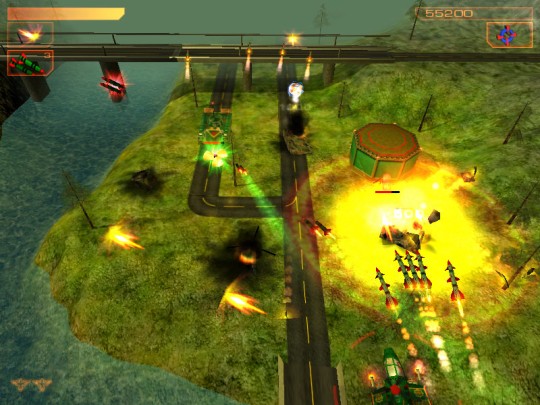
My, what big rockets you have.
FREE PLAY - Maziacs PC (PeeJay’s
Remakes)
The problem with unlicenced clones, as
noted in the Indie Zone intro, is that all too often they not only
charge money for ripoffs of other people’s games, but don’t even
have the courtesy to acknowledge where they’ve copied them from. The
burgeoning “remakes” sector is a different kettle of fish
altogether. Here you have coders bringing old games up to date for
the modern age, for free, and openly and properly crediting the
original creators by admitting whose game it was in the first place.
This is one of Indie Zone’s very favourite remakes, right up there
with the fantastic Skool Daze update Klass Of 99 (which incidentally
has recently been rereleased in a Windows version).
It’s a rewrite of a fondly-remembered
Don Priestley game from the early days of the Spectrum , in which
your intrepid adventurer searches a maze populated by creepy
spider-like monsters in search of gold. The Speccy version was famed
for the dramatic fight scenes when you encountered one of the
Maziacs, and this remake adds its own twist, the surprise of which
Indie Zone won’t spoil for you. The game comes with both
original-style graphics and a whole range of other selectable
“skins”, and offers both “classic” and updated gameplay options.
http://www.peejays-remakes.co.uk/ - more remakes by the same
author
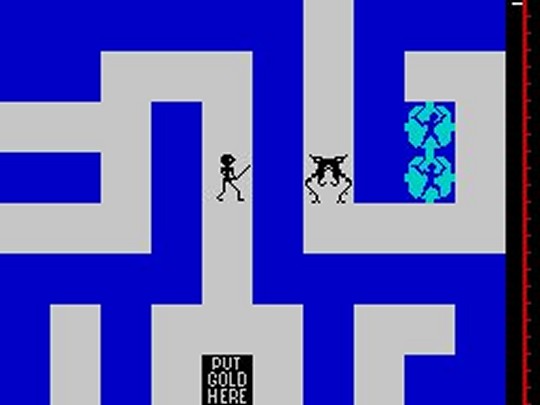
The
original Speccy game, with a horrible Maziac.
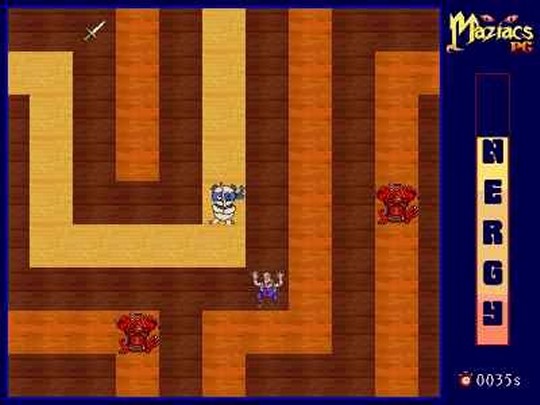
In
the remake, you’re a ninja bear. Cool!
|
INDIE ZONE - ISSUE 142 (Jun 2004)
As mentioned in Free Play a couple of
issues back, one of the odd things about “progress” in gaming – and
more specifically, gaming technology – is how certain things get
completely left behind. It’s like never having another cup of tea in
your life, just because you’ve discovered beer. Today’s modern
graphics cards can display incredible textures and lighting and
detail and all the rest of it, but the advent of CGI in movies
didn’t stop people making cartoons, did it? The fact that odd French
feelgood movies (say, Amelie) can be made in glorious real-life
Technicolour doesn’t mean that muted-tones animation isn’t still a
valid alternative way to express similar sentiments (as in, say,
Belleville Rendezvous).
Major publishers generally lack the
vision to create games showcasing anything but the latest technical
state of the art, but indies are free to try more eclectic or
abstract styles, ironically displaying a considerably greater level
of artistic maturity by doing so. This month, Indie Zone looks at a
couple of examples.
PLATYPUS
(Retro64, $19.99 – about £12 at time of writing)
Min spec: 300MHz CPU, Direct X 7.0, Direct 3D. Rec spec: none
stipulated
The author of Platypus apparently
modelled every single object in the game in real-life Plasticene
before photographing them and turning the pics into sprites, and the
attention to detail has really paid off in this uniquely
good-looking shooter. Indie Zone isn’t really sure why more games
haven’t used this distinctive and time-honoured technique (hey, if
it’s good enough for Wallace And Gromit it should be good enough for
PC games), but it’s good news for Platypus, as it means it gets to
stand out from the crowd in a way that it perhaps wouldn’t if it
relied on “standard”-type graphics to depict its straightforward
shooting action. This is real old-fashioned stuff, with none of the
fancy gameplay fripperies of rRootage (see Free Play) - you get a
few basic time-limited powerups, a raft of baddies and some massive
boss enemies at the end of each stage, and that’s about it.
But it’s beautifully executed and with
an admirably challenging difficulty setting, both in terms of the
resistance put up by the little Claymation bad guys themselves and
in the fact that you only get a couple of credits with which to play
through each of the five long stages (each with several sub-levels).
In truth, the stages are slightly too long and a bit repetitive
until you reach the splendid bosses, but marvelling at the graphics
(even the explosions are rendered in Plasticene) will keep you
distracted from that fact well into the proceedings. As a
bog-standard space shooter you probably wouldn’t give Platypus a
second glance, but its Play-School stylings are so loveable it’s a
bargain at the price.
PC
ZONE VERDICT Just £12? Put it on your bill. A-ha ha. Ha. 74%
http://www.retro64.com/platypus_game.asp
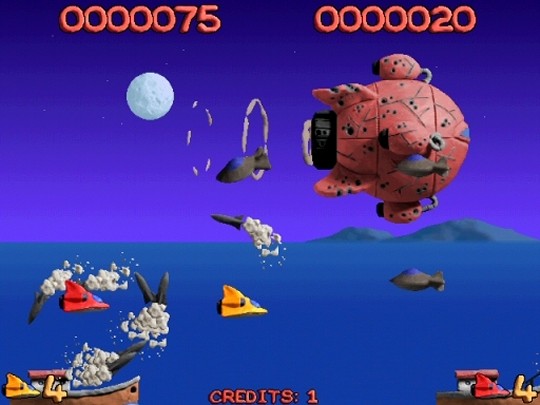
A trouble shared is a trouble halved.
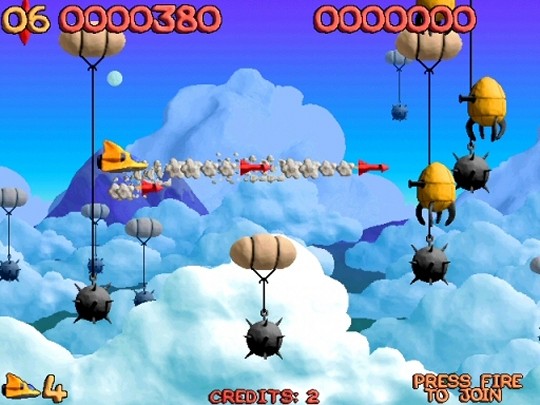
Not the safest way to transport mines.
FREE PLAY - rRootage (ABA Games)
Superficially reminiscent of the
mighty Warning Forever (from the first ever Free Play column), this
abstract shoot-‘em-up is in fact a very different game in play, and
marks the pinnacle of a series of games in a similar vein from
Japanese shmup-coder “Saba”. As you can see, the graphics are
extremely minimalist, but they conceal a highly-sophisticated
shooter which actually includes stripped-down versions of three of
the most popular arcade/console shooters of recent years: Giga Wing,
Psyvariar and Ikaruga.
rRootage takes the weaponry, enemies and fire
patterns of those three games and transposes them into its own
wire-frame world, in the form of 10 individual levels for each mode,
played as score attacks. (There’s also a 10-level Original Mode.)
It’s shooting in the purest form imaginable, and in the four game
modes there’s a surprisingly wide variety of playing styles, from
the reflect-shield-based Giga Wing levels to the Psyvariar ones,
where you get more bonuses and firepower the closer you scrape
against the enemy bullets. While the graphics couldn’t be any
simpler, they have a real beauty of their own, and while it only
partially comes across in screenshots, you now have no excuse for
not admiring it in action.
http://www.asahi-net.or.jp/~cs8k-cyu/windows/rr_e.html

I think you’ve got him worried.
|
INDIE ZONE - ISSUE 143 (Jul 2004)
or WHAT IS KNOWN AS… SHELFLIFE
One of the most dismaying things about
the world of games as opposed to other forms of culture is the
incredibly short shelflife of the typical release. While it’s easy
to walk into a High Street shop and buy a 20-year-old Rolling Stones
album, try getting hold of any game released more than three months
ago and see how far you get. This is one of the greatest advantages
of the web-distributed indie scene – as long as you don’t do
something fat-headedly stupid like put a year, or inappropriately
time-specific setting, in your game’s title, nobody need ever know
that it’s ancient, and you can continue to sell it indefinitely as
if it was the hottest new thing on the block. Hurray for those
clever folks in the indie scene, eh?
BOULDER DASH XMAS 2002 EDITION
FlyOrDie Software, $19.99 (approx £11 at time of writing)
Minimum/recommended specs: None given – any PC should run this.
The history of Peter Liepa’s
rocks-and-diamonds puzzler Boulder Dash is a long and confused one
since the released seminal 1984 original, and the game is one of the
most unofficially-cloned designs of all time. FlyOrDie contributed
their own bit of water-muddying to the story with their “inspired
by” title GemJam a few years ago, but since then have ponied up for
the official licence and made several officially-endorsed Boulder
Dash titles. Adding to the mystery is the fact that GemJam isn’t
much cop and their later “Treasure Pleasure” official BD sequel is
rubbish, completely missing the point of what made Boulder Dash
great, while this – released between the two - is by far the best
game in the series since the first one. A genius piece of sensitive
designing, it takes a perfect grasp of the heart and soul of the
original game and adds only sparingly to it to create the most
compulsively addictive thing this reviewer’s played in about a year.
It deserves a wide audience, so if you have any complaints about the
fact that Indie Zone’s reviewing an 18-month-old game, kindly go
stick your head in a pig.
Offering 50 levels - plus 15 optional
tutorial ones if, as is alarmingly possible, you’ve never played a
Boulder Dash game before - BDX2002E (Indie Zone is sure that was the
registration number of its first car) lures you in with a few quick
and simple stages that can be completed in under a minute, but then
steadily ramps up the difficulty until you’re faced with levels that
you’re head-scratchingly CERTAIN just can’t be done, until in a
lightbulb flash of inspiration you realise the solution. Helpfully,
the map structure lets you go off and try different stages if you
get stuck on a particular one, and only the slightly rubbish
save-game implementation (just one too-easily-overwriteable slot,
and idiotically saved to the bastard registry rather than a handy
file) lets it down at all.
The levels are wildly varied in puzzle
style, so it never feels repetitive, and so fiendish that the sense
of reward for beating one is heartwarming. For eleven quid, no-one
who fancies themselves as a lover of videogames should be without
this. Think the graphics are too basic for such a score? Kill
yourself.
PC ZONE VERDICT: Tremendous and compelling update at bargain price.
90%
http://www.flyordie.com/games/download/bd-xmas.html

Balloons are among the new features.
FREE PLAY - PACMAN
WORLDS (Danjo Software)
One of the very few games which can
lay claim to being more ripped-off than Boulder Dash, of course, is
Pac-Man. There have been literally hundreds, probably thousands, of
Pac-clones, the vast majority of which are total rubbish. This one,
however – despite presentation that’s just asking for a slap, like a
teeny windowed mode and an always-default fullscreen mode that
irritatingly screws up your desktop – takes the concept and extends
it in a thoughtful and entertaining way, while maintaining the
all-important game balance that so many clones entirely miss. It’s
easy to imagine one of the official Pac-sequels taking this clever,
more exploratory route away from the original game, with a handful
of well-chosen additions like the “policeman” ghost who comes out
and chases you if you use the turbo power-up in sections of the
mazes marked by speed-limit signs.
Full background and instructions
can be found within the game, the complete version of which is
included on this month’s coverdisc, so find out for yourself.
http://www.megagames.com/news/html/freegames/pacmanworlds.shtml
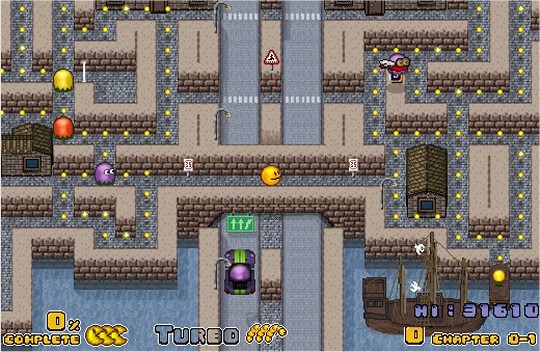
Pac-Town, the game’s central hub area.
|
INDIE ZONE - ISSUE 144 (Aug2004)
One of the more disappointing things about the world of games is its
lack of crossover with other forms of culture. Bar licenced games of
big-budget movies, games exist mostly in a cultural vacuum, never
referencing the worlds of music or art or literature or even the
media. If games make a point, or a joke, it’s usually a point or a
joke about other games, not about anything in the wider world. It’s
odd when you think about it, because games are at least as
of-their-time as other cultural forms, if not more so – good luck
running the average four-year-old videogame on the hardware platform
of the moment – so you’d expect them to be even more contemporary in
their references. This month’s featured game doesn’t exactly come
under that category, but it’s a start.
ART IS DEAD
(Small Rockets, $14.99 – about £8)
REQ: P2-233, 32MB RAM, 4MB gfx)
Lightgun games don’t tend to crop up
on the PC very often, and for good reason – you’d have to be pretty
sad to sit pointing a plastic gun at your PC’s monitor from two
inches away and pretend you were being presented with some sort of a
challenge. (Except, perhaps, the one resulting from the gun
obscuring your view of the screen.) Sadly, this fact has robbed the
PC of some of the finest arcade games to come to home gaming
platforms, such as Namco’s fantastic Time Crisis and Point Blank
series. The latter – a bright, fast-paced cartoon shooter stuffed
with blink-and-you’ll-miss-‘em mini-challenges – is the inspiration
for Art Is Dead, a lightgun-style blaster (except using the mouse)
in which you participate in a wide range of minigames set against
the backdrop of classic works of art.
While the mini-challenges of Art Is
Dead are neither as inventive nor as snappy as those in the Point
Blank games, this is still a quick and entertaining shooting-gallery
game, with “gallery” being used in a more literal sense than usual.
It’s arguable whether a mouse and crosshair negates the entire point
of this sort of game, but it’s certainly sent your Philistine
reporter off to find out what some of the priceless works he’s been
blowing holes in actually are, which automatically makes this the
most edutainment-tastic thing since The Typing Of The Dead, and as
ever the joy of indie games is that at the likes of eight quid, they
don’t have to be mega-epics to justify their price. Indie Zone may
not know much about art, but it knows what it likes.
PC
ZONE VERDICT: Indie Zone likes this. 79%
http://www.smallrockets.com/pc/artisdead/

Well, you’d shut your eyes too.
FREE PLAY: STAR WARS – THE BATTLE
OF YAVIN (Bruno R. Marcus)
The Star Wars videogaming franchise is
one that’s been increasingly devalued over the last few years by an
avalanche of highly-mediocre titles, steadily pissing all over the
legacy of much-loved games like X-Wing vs TIE Fighter and the
original Atari vector-graphics coin-op (which is still Indie Zone’s
favourite SW game by a mile). However, a freeware coder is
attempting to fight back against the Dark Side of LucasArts’
licencing department, with a whole series of games taking Star Wars
back to its roots.
The latest is The Battle Of Yavin, a
highly-impressive 3D outing written with TrueVision3D, and styled
very much in the footsteps of the original arcade game - there’s a
space-battle section with massed ranks of X-Wings, B-Wings and TIE
fighters, attacks on the Death Star surface, and then a climactic
run through the famous trench. It’s a very simple game, with no
fancy controls or weapons to get to grips with – you just fly around
and shoot stuff – but with scores of fighters all pursuing their own
private battles, and all sorts of attention to detail, it creates a
more convincing sense of a real space dogfight than any of the
official SW releases on the PC. It’s tough too, but you’ll keep
coming back for another kicking, because this is purest essence of
Star Wars. And it’s free.
http://www.bruneras.com/ - more info and more Star Wars games by
the same author
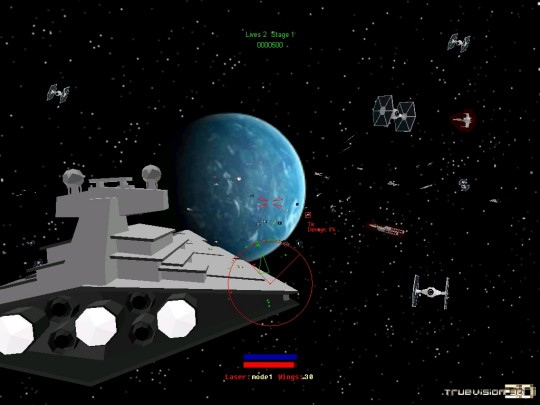
Ooh, it’s like Piccadilly Circus up there.
|
FREE PLAY - ISSUE 145 (Sep 2004)
A couple of months ago, alert readers
may recall Indie Zone railing against plagiarism in
independently-produced PC software. The blatant unacknowledged
copying of other people’s games is indeed a curse, but that doesn’t
mean developers can’t take large slices of inspiration from earlier
titles. This month, we look at a couple of releases which borrow
heavily in one way or another from previous games, but bring more
than enough of their own to the table to justify the pinching.
DEMONSTAR SECRET MISSIONS 1
Mountain King Studios, $19.99 (approx £12)
Min spec: DirectX 5 Rec spec: None specified
Seibu Kaihatsu’s 1990 coin-op Raiden
is one of the most influential arcade games of all time. Many games
have paid homage to it in the subsequent 14 years, and most
scrolling shoot-‘em-ups can trace their history back to it in
greater or lesser part, but never has closer tribute been paid than
in Mountain King’s Demonstar series (of which SM1 is the second).
Indeed, the game lifts the design of the Raiden spaceship, and the
taking-off-from-the-carrier-deck intro to each level, almost
pixel-for-pixel, but aside from such superficial nods to its
inspiration (and the odd glance back at Amiga favourite SWIV) this
is a game which follows the Raiden design template to a degree that
verges on stalking, albeit that all the game’s eight actual stages
are entirely new (and the graphics are somewhat sharper and lusher
than Raiden ever managed).
What that means in practice is a
tough, well-balanced, no-nonsense shmup that you can devote the odd
blissful, brainless half-hour to for a straightforward but demanding
test of your joypad skills. It’s a challenge - not least because of
some slightly suspect use of colour causing enemy bullets to
sometimes get lost in the onscreen mayhem, the game’s one noticeable
flaw – that you’ll keep coming back to, because the only Continue
option puts you all the way back to the start of the last stage you
reached. There’s no lazy quicksaving your way through games like
Demonstar, nor even the pump-more-cash-in option of playing Raiden
in the arcade. To see the end of this, you’ll just have to plain
old-fashioned earn it. This reviewer hopes that’s not enough to put
the modern PC gamer off it altogether.
PC ZONE VERDICT: What are you,
scared? 82%
http://www.mking.com/demonstarsm1/index.html
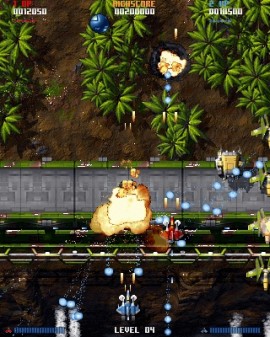 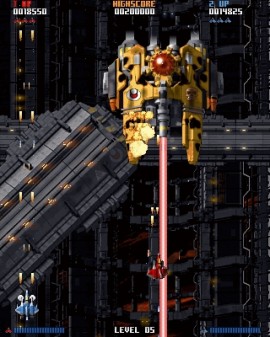
FREE PLAY - CODENAME:
GORDON
(WoS note: the text below never actually made it into the
magazine. PCZ were too uncomfortable with slagging off Half-Life
with the sequel imminent, and I wasn't prepared to fudge the piece,
so the editor totally rewrote the Codename: Gordon section himself.)
Indie Zone is about to say something
slightly controversial here: Half-Life is crap. Yes it is. It had
unrivalled atmosphere, great film-esque direction and a fairly
compelling plot, but in gameplay terms it was an irritating 3D
rewrite of Dragon’s Lair – walk along, have something happen that
you couldn’t possibly have foreseen, get killed, quickload and try
again but remember where the surprise is coming from this time –
with the addition of totally inappropriate platform-game elements
that meant you died almost as often by falling off ladders as by
getting mangled by horrible alien space beasties. Seriously. It’s
shit. Sort yourselves out. Still, Indie Zone realises it’s swimming
somewhat against the tide on that one, so it’s entirely possible
that you’re simply going to adore Codename: Gordon, which Indie Zone
hates more than the last git who keyed Indie Zone’s car.
It is, as the URL somewhat gives away,
essentially Half-Life interpreted in 2D, and while it started off as
a bootleg “tribute”, it now carries the official seal of approval.
It includes most of the original game’s design features, and even –
despite being a 2D platform game – retains the mouse-and-keyboard
control method. The action is depicted in cartoonish,
beautifully-shaded graphics that bring to mind the nicer parts of
Metal Slug, and while Indie Zone can’t bear to play the horrible
thing, the chances seem favourable that you’re going to like it. You
freaks. The game can be downloaded via Valve’s innovative Steam
network, or if you’d prefer to have your download finish before the
sun cools and a new Ice Age dawns, the file is now widely spread
across all the major P2P filesystems.
http://en.wikipedia.org/wiki/Codename:_Gordon
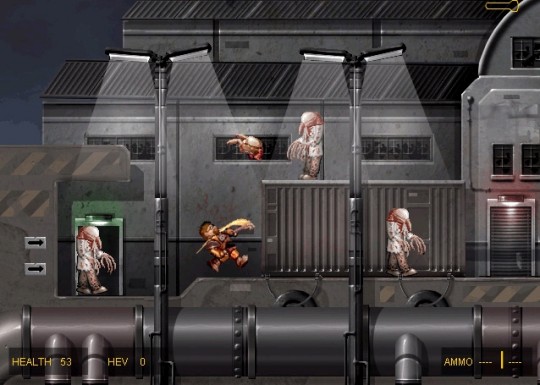
|
FREE PLAY - ISSUE 146 (Oct 2004)
Indie Zone may have mentioned this before, but one of the joys of
the indie scene is the keeping alive of game genres which the
mainstream has long since abandoned. During the war, when Indie Zone
were a lad, it was all cute platform games around here, but when did
you last see one on the PC? And yet, the form didn’t suddenly stop
being entertaining, did it? Of course, sometimes revival can go too
far. Ask Dr Frankenstein.
SUPERSTAR CHEFS
Arcade Labs, $19.99 (about £12)
Min spec: Direct X
A few months ago, Indie Zone expounded
at some length on the issue of plagiarism in independent games, and
specifically the blatant remaking for profit of old games with no
acknowledgement to the original creators. Which puts your reviewer
in a bit of a spot when someone remakes one of his all-time
favourite games of the 90s, does a lovely job of it, but shamefully
fails to admit that that’s what it’s actually done. The game in
question here is Team 17’s budget-price 1993 Amiga platformer Qwak,
and Superstar Chefs is an absolutely unabashed clone of it. Made up
of 64 single-screen platform levels where your object is simply to
clear the screen of fruit, Chefs adds a few minor new elements and
changes to the original design, but to all intents and purposes this
is Qwak 2004, except that the player’s avatar is now a cook instead
of a duck.
The graphics, like the original’s, are
small but beautifully packed with colour and character, and the
wraparound levels are simple but fiendishly designed. At first it
seems overly-easy, especially on the default middle difficulty
setting, with enemies that just do their own thing rather than chase
you and a plentiful supply of extra lives to add to your generous
initial allocation, but it’s all too easy to lose four in about 20
seconds if you’re not giving a level your full attention, and with
no continues it’ll take a lot of skill to get through every stage.
There are also two different two-player modes – a co-operative game
and a best-of-seven-stages highscore battle mode, and generally
there are many hours of fun to be had for the money, though 12 quid
seems a little steep for a game whose setup file is only 1.7MB big.
So how to solve the reviewer’s
dilemma? Well, since this is essentially the same game your reviewer
played in 1993 he’s going to give it the same score he did then,
except with 20% deducted for the flagrant theft
of someone else’s work without so much as a nod of credit. (Adding
insult to injury, the website describes Superstar Chefs as “similar
to Bubble Bobble and Mario Bros”, two games which the game is
nowhere within a mile of as similar to as it is to Qwak.) It’s a super little
game, but this kind of thing really has to stop.
PC ZONE VERDICT: A good ripoff of someone else’s genius. 69%
http://www.arcadelab.com/chefs.html
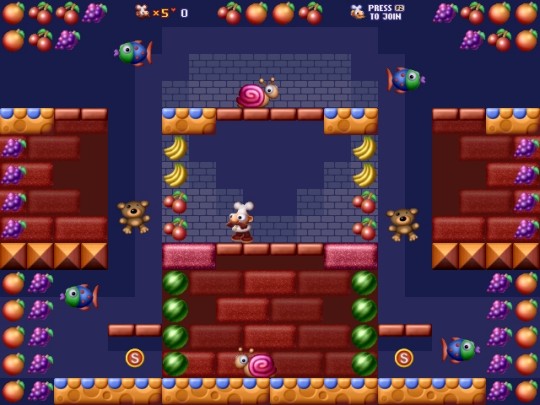
You just don’t see colours like that
anymore.
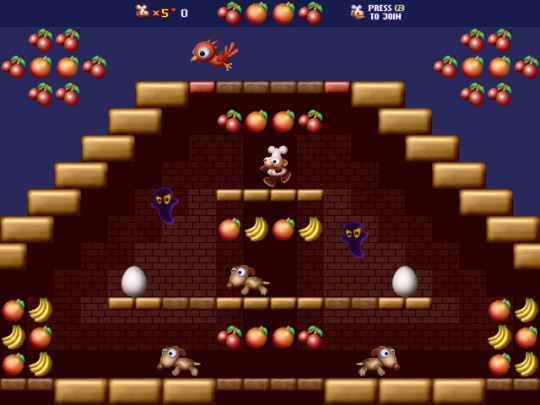
An odd situation for a chef to be in.
FREE PLAY - MARIO
FOREVER
Well, after all that wibbling we
haven’t got much space left to tell you about this month’s Free Play
game, so it’s lucky that it doesn’t take a lot of explaining. The
PC’s seen a fair few attempts at Mario knockoffs, but this one from
a Polish outfit Buziol Games is easily the most accomplished one to
date. Borrowing graphics and music from the SNES Super Mario All
Stars and Super Mario World, but creating new and original level
designs in the style of the original Super Mario Bros, this hybrid
is almost as captivating as the real thing, though the scrolling and
controls could both stand a little extra smoothness. Every bit as
much a clone as this month’s commercial indie effort, of course, but
this one doesn’t try to either disguise its origins or profit from
them.
http://www.acid-play.com/download/super-mario-3-mario-forever/
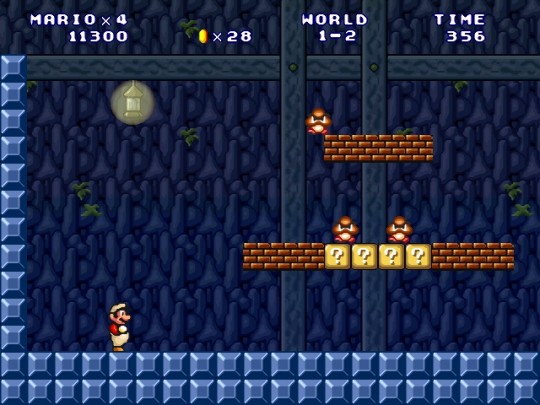
“How do I keep getting into this?”
|
INDIE ZONE - ISSUE 147 (Nov 2004)
This month, Indie Zone encountered
something of a dilemma. (Have we ever mentioned what great cars they
are?) This column was set up specifically to give coverage and
encouragement to independently-produced games, so what do you do
when something comes out that’s interesting, yet not actually very
good? After much soul-searching, Indie Zone decided that the best
thing to do is offer constructive criticism, on the grounds that
online-distributed games are a lot easier to update and release
improved versions of. Hey, we’re here to help.
SKOOLS OUT
Mucky Baby £7.99
Min spec: P600, DirectX 7.0, 100MB disk space
Skools Out (sic) is a pretty
transparent attempt to recreate the magic of the legendary Spectrum
game Skool Daze, while transporting into the modern
three-dimensional era. Developers Muckybaby have partially
succeeded, which is to say they’ve got the “3D” part down pat – the
game is set in a very nicely-rendered environment, incorporating
(briefly) the hero’s home, and then a sizeable school with
playground, sports field, outbuildings and suchlike. Pupils and
teachers scurry around, occasionally muttering pithy comments, and
objects can be examined and manipulated.
Sadly, however, the gameplay hasn’t
had anything like the same care lavished on it. There’s barely a
skeleton of a game here, with most of the player’s time occupied in
simply wandering around the school, looking in cupboards. Unlike
Skool Daze there’s no need to actually attend classes – if you fail
to show up, nobody bats an eyelid, and you can have free run of
every room in the building. All classrooms are empty except the one
you’re supposed to be in, and even if you do decide to be a model
pupil (attending classes and answering multiple-choice questions is
the only way to reduce your lines tally), you’ll have a job finding
the right room before the end of the lesson, given the absence of
any maps, signposts or helpful arrows.
It’s a shame, because there are
undoubtedly the beginnings of a really neat game here. As it stands,
however, it’s barely more than a tech demo. Indie Zone’s
recommendation, then, is that you keep a close eye on the website
and hope for revisions. A-ha ha.
PC
ZONE VERDICT Could do better. 44%
http://www.serialgamer.com/direct-170754.html
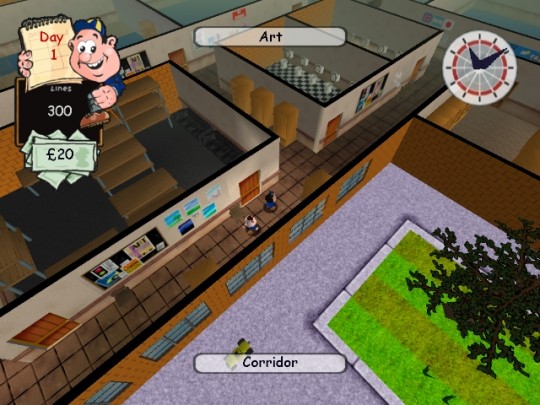
Good luck finding where “Art” is.
FREE PLAY - LIGHTNING BREAK
Of all the games we’ve brought you
since this column started nine months ago, this is the one that’s
occupied most of Free Play’s own time, and the one that’s been most
popular with all of Free Play’s friends. It’s a (loosely)
snooker-based game, and it’s a work of genius. On each of the game’s
20 levels, you’re set a particular task – say, pot two red balls and
two coloured balls – and given a time limit to do it in. Potting the
wrong ball or the cue ball, or not hitting any balls at all, knocks
four seconds off your time, and that’s pretty much it for rules. The
control system is incredibly simple (aim with the mouse, hold down
the left button to set power), the implementation of the laws of
snooker is extremely forgiving (you can hit any ball you like at any
time, you’re only penalised if you pot them), and there’s all sorts
of potential for setting up clever stuff like combo shots, whereby
you can save time by sinking several balls at once.
As you move through the levels the
challenges get more inventive and more cunning, culminating in Level
20’s challenge to score a 147 break against the clock. (Don’t worry,
it’s not as daunting as it sounds, thanks to the lax rules and the
big pockets.) The game keeps average and high scores both for
individual levels and the whole game, and if you’re anything like
Free Play, you’ll be playing it constantly for days, first to work
through all 20 stages (after 20, the levels repeat with tighter time
limits for extra challenge) and then to better your scores.
Lightning Break is a work of art in 300K of Flash code, and if you
have more fun with any PC game this month, free or otherwise, you’re
probably lying.
http://www.maniacworld.com/Lightning-Pool-Game.htm
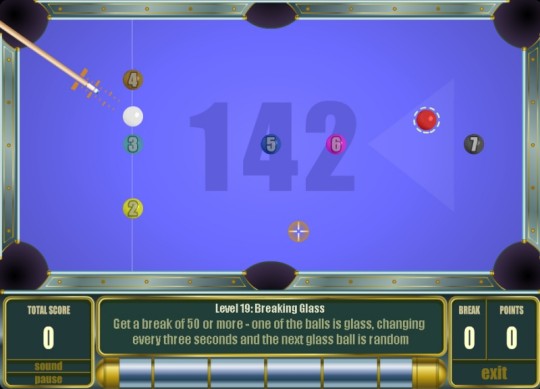
Do you love the sound of this level? Ho!
|
INDIE ZONE - ISSUE 148 (Dec 2004)
or GOD SAVE THE QUEEN
One of the things that’s been most sadly lost in the games industry’s transition from a million bedroom coders to half-a-dozen global corporate megabusinesses is the distinct flavour of Britishness in videogaming. Dear old Blighty was once a huge creative force in the world of games, pushing back both the technical and artistic envelopes in a way that US or Japanese developers never seemed able to do. Tragically, all the legendary innovators of the 8-bit and 16-bit eras have now been either marginalised or driven out altogether (see last month’s interview with Sensible Software’s Jon Hare for an example), and only the indie scene remains as an outlet for the UK’s inventive gaming minds.
DEADEYE
Redpoint, £5
Min spec: Anything more powerful than a ZX81.
Alert readers may have noticed this column’s fondness for old-school arcade-style shooting games, but even Indie Zone’s never gone quite this retro before. Deadeye is an unashamed homage to the classic single-screen coin-op shooter from the age of Galaga et al, but in gameplay terms this is no simple remake. As the name suggests, Deadeye is a game all about precision – if you blast away like a redneck with a chaingun, you’ll get through the game’s 50 levels, but you’ll end up with a score that will make six-year-old girls point at you and laugh. Deadeye rewards players lavishly for two things – not wasting bullets, and taking risks. Wait until the enemies are almost on top of your ship before you zap them, and shoot without missing, and you’ll rack up enormous bonuses, as well as other goodies like score multipliers and shields, which can be used to glean even more bonuses, and so on.
This is a game designed for true aficionados of the Galaga-style form, and as well as being disturbingly addictive in its own right, it’s packed with secret things to discover and unlock even if you can’t get near the colossal scores on the online high-score page. Only the presentation lets it down slightly – the unadorned, non-resizeable game-screen looks a bit forlorn on desktop resolutions higher that 1024x768, and there’s no full-screen option – but this is a game with hidden depths that it’ll take you weeks to get anywhere near mastering, while still being simple and friendly enough not to crush you like a bug if you aren’t totally hardcore. At five quid, not giving it a go would be not only stupid, but frankly offensive.
PC ZONE VERDICT
For the purist, the purest.
90%
http://www.wayoftherodent.com/gd101/bs_deadeye.htm - homepage, with 15-level demo
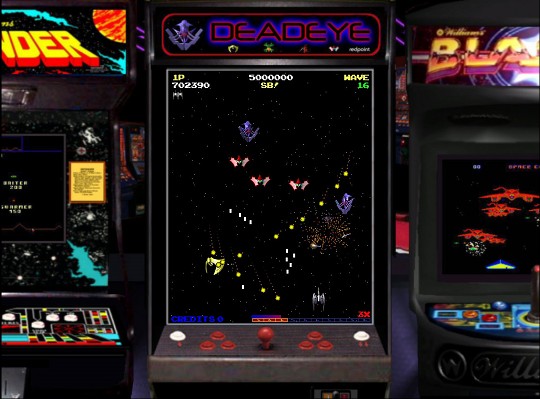
So old-school it’ll give you lines if you’re late.
FREE PLAY
- WILD WEST HERO (Skyclad Monkeys)
Only the British could look at the seminal Williams coin-op Robotron and decide, “Y’know, the problem with this is that it’s too complicated and intellectual”. So in 1983, Spectrum coder Paul Holmes came up with a game that - like Deadeye - stripped the concept down to its absolute rudiments and chucked away all the frippery, leaving only the Zen-like core at the heart of the gameplay. Wild West Hero presented just one type of enemy, in ever-increasing numbers, and a little robot dude whose gun fired automatically, leaving nothing for the player to do but enter a trance-like state below conscious thought, and endlessly slaughter the bad guys until being finally overwhelmed.
The game’s only problem was that the Speccy’s technical limitations rendered later screens unfathomable, as the enemy sprites XORed each other out of existence, leading to the player being unfairly killed by what looked like empty space. Luckily, an alert historian has solved that problem with this splendid PC remake, almost indistinguishable from the original except with baddies who don’t disappear from sight if two of them are standing on the same spot. This is a game you can play without employing your higher brain centres at all, and if you’re a competitive gamer seeking that elusive mental place known as “The Zone”, in which most victories are found, then Wild West Hero is the best training for finding it that you could ever hope for.
http://www.geocities.com/wildwesthero2004/ -
updates and other games from the author
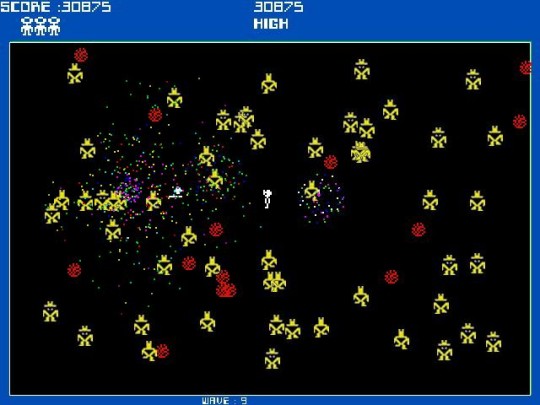
Don’t think about them. Destroy them.
|
INDIE ZONE - ISSUE 149 (Christmas 2004)
Atari’s Occasionally, viewers, Indie Zone does wonder if anyone's actually reading this page. After all, month after month we feature games of types that never usually show up on the PC. This month, for example, we've got a game about a hamster rolling down slopes, and a game about jumping on arrows in time to music. Neither of them feature realistic simulation elements, foot-thick manuals, or World War 2 scenarios. Do you even care about them? Are you even reading these words, or have you all skipped excitedly forward to news of the latest mods to make all the walls in Doom 3 dayglo pink so you can see WHERE THE BLOODY HELL YOU'RE GOING in it? Is there anybody there? Hello?
HAMSTERBALL
Raptisoft, £7.14
Min spec: none specified
Marble Madness. Let’s just get it out of the way nice and early, shall we? Hamsterball is an unofficial remake of/sequel to Atari’s legendary 1984 coin-op, copying the “roll a ball down a chequered 3D pyramid thing” exactly but replacing all the level designs with new ones. You get 12 geometric mountainsides to traverse here rather than the original five, you’re a hamster in one of those perspex exercise balls rather than a marble, and there are a couple of new features (such as the Escheresque
“Odd Race” where the perspective changes from one floor tile to the
next, and the circular saws which suddenly slice half the floor away
from under you), but basically this is Marble Madness 2004.
It’s a beautifully-executed job,
though – gorgeous to look at and fiendishly designed. Almost too fiendishly, in fact, as it gets quite staggeringly difficult by around the halfway mark, and Indie Zone suspects that a large percentage of PCZ readers will simply never see the last few tracks, which seems a terrible shame given the effort that’s clearly gone into designing them. Even in the game’s “Pipsqueak” mode, which boosts your time limit and does away with all the moving enemies, and is great fun for young kids, time gets absurdly tight later on, and the mode doesn’t unlock the various courses for time-trial races anyway. Turn the enemies back on and a few of them (including the aforementioned saws, and the seemingly arbitrary and unavoidable giant mallet) seem a tad unfair too, which is a bad flaw in a game where every second counts.
On the upside, there are multi-player battle modes to discover, though to make the most of them you’ll need a full complement of control devices (mouse, joypads and for one unlucky sap who might as well just give up at the start, keyboard), and Hamsterball is so loveable as to allow most of these faults to be forgiven.
For those up to the challenge this is a fantastic game, and the asking price is an absolute bargain. Once again, though, Indie Zone has to sadly deduct 20% for the shameful way that the developers of a blatant remake have failed to even passingly acknowledge or credit the original game whose ideas they’ve copied. Tch.
PC ZONE VERDICT
Did anyone say “hamsterrific!” yet?
66%
http://www.raptisoft.com/hamsterball.shtml
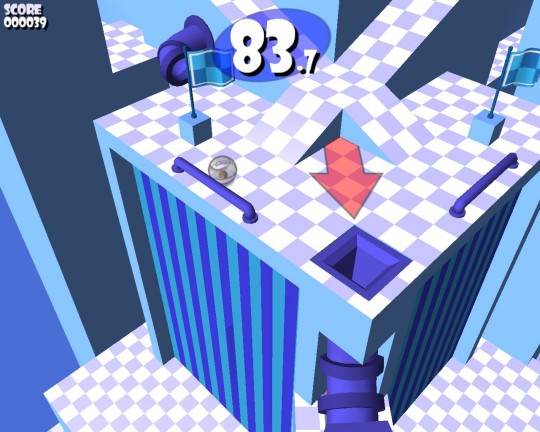
My rats live in a setup not dissimilar to this.
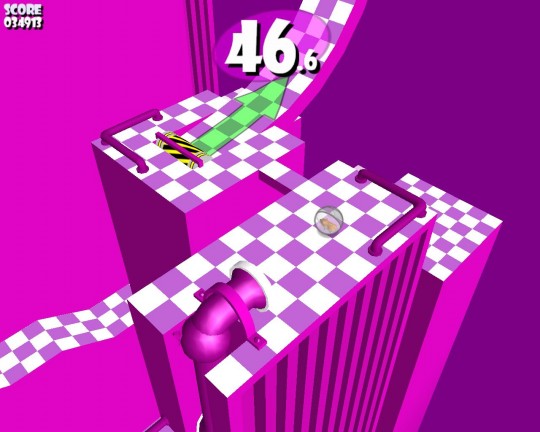
FREE PLAY
- STEPMANIA
Konami’s arcade dancing game Dance Dance Revolution (aka the much less snappy Dancing Stage over here) has been one of the company’s greatest-ever moneyspinners, largely due to the fact that each iteration of the series features only a couple of dozens songs, of which you’ll only ever have heard of a small handful (the rest being made up of in-house Japanese Eurodisco soundalikes). By this simple but cunning measure, Konami can keep releasing pretty much the same game over and over again, in a manner that makes EA Sports look like models of artistic restraint and leaves dance-loving gamers frustrated at the need to load up eight different versions just to get all the songs they like in one session.
Thank goodness, then, for Stepmania.
A stupendous collaborative work, Stepmania is a PC remake of DDR which implements every feature of even the latest incarnations of the real thing, and which is produced in an open format enabling anyone to create “step files” (the sequence of arrows you have to dance to in time to the music) from any piece of music they feel like. Every track from every version of DDR has been converted, but also countless hundreds of other songs, and you can compile playlists comprising only your own personal favourites.
Contributors have also created background pictures, commentator files and every possible other addition necessary to make precisely the DDR game you always wanted.
Oh, and incidentally, if you can’t bring yourself to entertain the idea of leaping around on a plastic mat in front of your PC, Stepmania played with the cursor keys is actually a brilliant old-school arcade-type reaction and co-ordination game. You don’t need to dance to enjoy it.
http://www.stepmania.com/
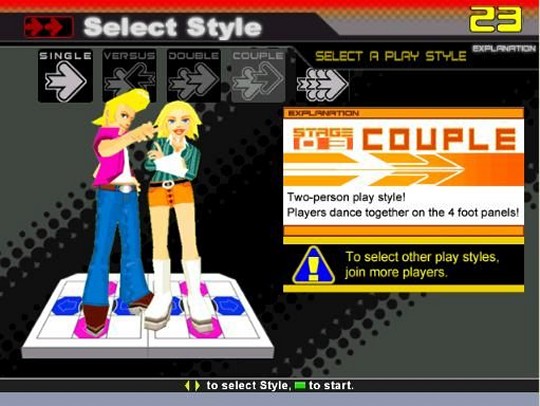
Only try this with a chaperone. Ideally one who's also a paramedic.? WoS Forum
|
|
|
|

